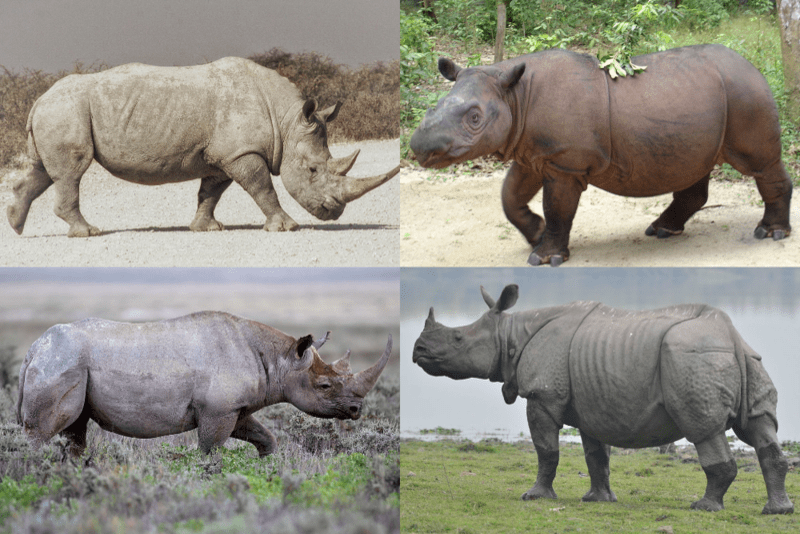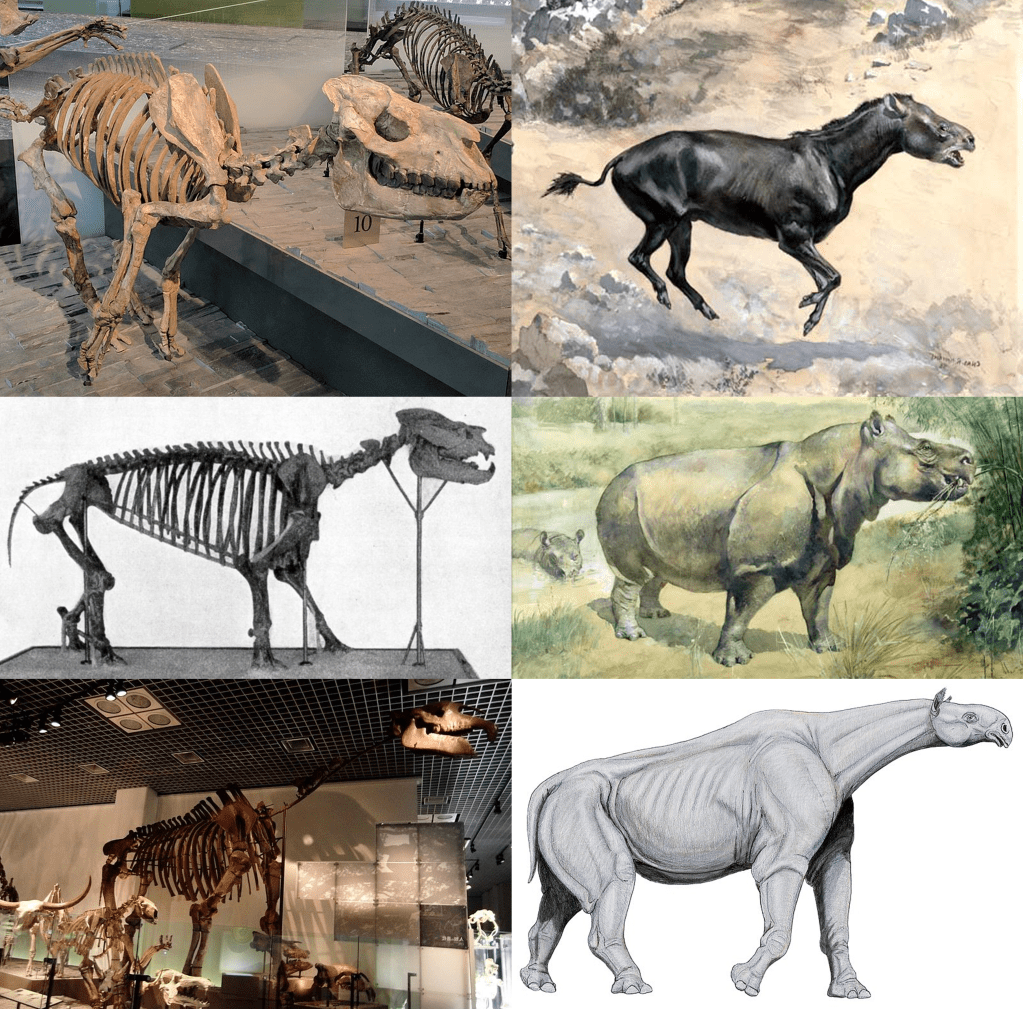Listen to Episode 129 on PodBean, YouTube, Spotify, or anywhere you can find it!
Known today for their large size and impressive horns, these animals have taken many forms over many millions of years. From horse-like runners to hippo-like waders to gargantuan behemoths, this episode we discuss the incredible evolutionary history of Rhinos.
In the news
Modern-style breathing in an ancient-style croc
Estimating color patterns in the skin and scales of ancient archosaurs
Fossils reveal gradual shrinking in orangutan evolution
Advanced scanning reveals unprecedented ammonite soft tissue
Charismatic Megafauna
Rhinos, with their large bodies, massive heads, and nose horns, are among the most iconic and recognizable animals on Earth. As part of the “odd-toed ungulates” (Perissodactyla), they are close cousins of tapirs and horses. Modern rhinos are found in Africa and Asia, they are all herbivorous, they live mostly solitary lives, and sadly they are all under severe threat of endangerment and extinction, with numerous subspecies considered extinct and two whole species currently restricted to single countries.

Top left: White rhino, Ceratotherium simum; Top right: Sumatran rhino, Dicerorhinus sumatrensis
Bottom left: Black rhino, Diceros bicornis; Bottom right: Indian rhino, Rhinoceros unicornis
Not shown here: Javan rhino, Rhinoceros sondaicus
Image by PaleoMatt, CC BY-SA 4.0
Like other perissodactyls, rhinos have an exceptional fossil record that provides an excellent picture of their evolutionary history, all the way back to the earliest perissodactyls of the Eocene. Modern rhinos all belong to the family Rhinocerotidae, but their extended family, the Rhinoceratoidea, includes a number of other major groups.

Image from Deng et a. 2021, CC BY 4.0
Rhinos a-Plenty
The earliest rhinos were nearly indistinguishable from the earliest horses and tapirs. From those small herbivores arose a few major groups. These include the Hyracodontidae, sometimes called the “running rhinos,” which were small- to medium-sized animals with long legs and slender bodies well-adapted for getting around quickly; the Amynodontidae, which included some very tapir-like rhinos as well as hippo-like rhinos sometimes nicknamed “aquatic rhinos” or “swamp rhinos,” which are thought to have been semi-aquatic; and Paraceratheriidae (or indricotheres), the “giant rhinos” whose largest members stood over 6 meters (20 feet) tall at the shoulder and weighed 15-20 tons, making them some of the largest land mammals in history, rivaled only by the very biggest ancient elephants.

Top: Skeleton and artwork of Hyracodon, a running-adapted member of Hyracodontidae.
Skeleton image by Dawn Pedersen, CC BY 2.0; Art by Charles R. Knight, 1896, Public Domain
Middle: Skeleton and artwork of Metamynodon, a possibly semi-aquatic member of Amynodontidae.
Skeleton image by Osborn, Public Domain; Art by Charles R. Knight, 1896, Public Domain
Bottom: Skeleton and artwork of Paraceratherium, one of the largest land mammals of all time.
Skeleton image by Momotarou2012, CC BY-SA 3.0; Art by Dmitry Bogdanov, CC BY 3.0
These diverse groups did well during the Eocene and Oligocene Epochs, but they were all extinct or nearly so by the start of the Miocene, leaving only the Rhinocerotidae, which would eventually include modern rhinos. Within this group, we see the evolution of numerous grazing specialists, hippo-shaped forms (like Teleoceras), large-bodied forms on par with the largest living species, and the origin of these animals’ most famous feature: horns.

Top: Skeleton and art of Menoceras, often cited as one of the earliest horned rhinos.
Skeleton image by James St. John, CC BY 2.0; Art by Robert Bruce Horsfall, 1913, Public Domain
Bottom: Skeleton and art of Teleoceras, famously hippo-shaped rhinos.
Skeleton image by Ray Bouknight, CC BY 2.0; Art by Robert Bruce Horsfall, 1913, Public Domain

Top: Skeleton and art of Elasmotherium, sometimes called “Siberian unicorns.”
Skeleton image by Altes, CC BY-SA 4.0; Art by DiBgd, CC BY-SA 3.0
Bottom: Skeleton and art of Coleodonta, also called woolly rhinos.
Skeleton image by Didier Descouens, CC BY-SA 4.0; Art by ДиБгд, CC BY-SA 4.0
Rhinos were extremely diverse during the Miocene Epoch, but they’ve been in decline ever since. At the end of the Miocene, they disappeared from North America, and then at the end of the Pleistocene, they vanished from Europe and northern Asia as well. In the past couple of centuries, human activity has continued to dramatically reduce the populations of the five remaining species of this once-dominant family of large mammals.
Rhino-Like Horny Beasts
The familiar rhino profile – a large body with thick limbs and nose horns – is not exclusive to rhinos. Several other groups evolved a similar appearance, easily mistaken for true rhinos. These included brontotheres, a group of perissodactyls that thrived during the Eocene; uintatheres, an even earlier group of large herbivores that exhibited very ostentatious skulls; and the enigmatic embrithopods, whose one famous rhino-like member, Arsinoitherium, sported a pair of enormous nose horns. Unlike true rhinos, the horns of these animals all featured bony cores, whereas modern rhinos’ horns are made only of keratin, with no major bony component.

Top: Skeleton and art of Megacerops, a brontothere.
Skeletal image by Postdif, CC BY 3.0; Art by Dmitry Bogdanov, CC BY 3.0
Middle: Skeleton and art of Uintatherium, a uintathere.
Skeletal image by Shadowgate, CC BY 2.0; Art by Dmitry Bogdanov, CC BY 3.0
Bottom: Skeleton and art of Arsinoitherium, an embrithopod.
Skeletal image by Aram Dulyan, CC BY 2.5; Art by Mauricio Antón, CC BY 4.0
More to Learn
Find lots of information about rhinos, modern and ancient, at the Rhino Resource Center
Learn more about rhino conservation on the IUCN Red List and the International Rhino Foundation
Some technical papers about rhino and perissodactyl evolution:
Deng et al 2021
Liu et al 2021
Steiner & Ryder 2011
—
If you enjoyed this topic and want more like it, check out these related episodes:
We also invite you to follow us on Twitter, Facebook, or Instagram, buy merch at our Zazzle store, join our Discord server, or consider supporting us with a one-time PayPal donation or on Patreon to get bonus recordings and other goodies!
Please feel free to contact us with comments, questions, or topic suggestions, and to rate and review us on iTunes
The wooly rhino skeleton photo looks like it has bony horns?? Is that actually preserved keratin?
LikeLike
Woolly rhino horns are keratin, not bone, just like modern rhinos. There have been woolly rhino horns found preserved in permafrost! That’s probably the case with the specimen in that photo.
LikeLike